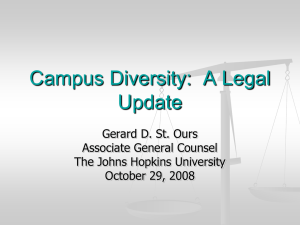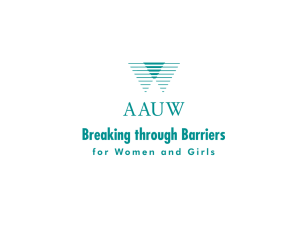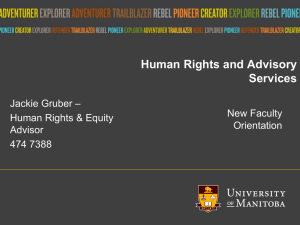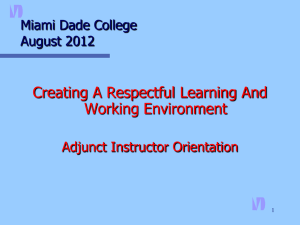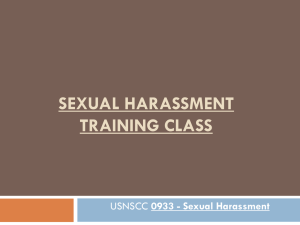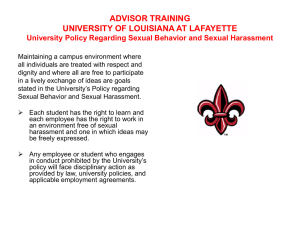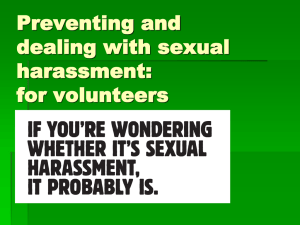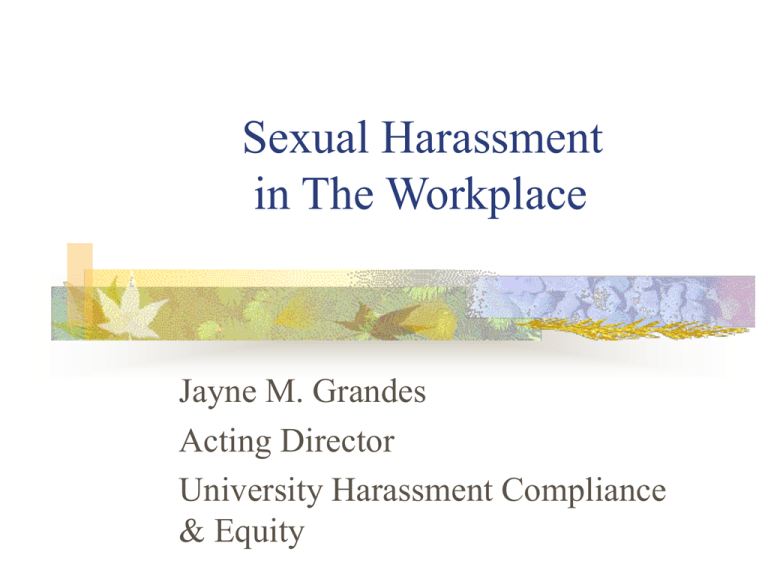
Sexual Harassment
in The Workplace
Jayne M. Grandes
Acting Director
University Harassment Compliance
& Equity
Federal Law
Title VII of the Civil Rights Act of 1964
Prohibits employers with 15 or more
employees to discriminate on the basis of
race, color, sex, religion or national origin.
The law applies to federal, state and local
employers and for all employment actions.
Federal Sexual Harassment Case
Law
1974 – first reported case of sexual
harassment
(1980 – EEOC said sexual harassment is a
form of sex discrimination)
1986 – first US Supreme Court decision set
forth guidelines defining sexual harassment
(Meritor Savings Bank v. Vinson)
Federal Case Law (continued)
(1991 – 1. CRA amendment allows jury
trials and increased damages 2. Anita Hill)
1998
Oncale v. Sundowner Offshore Services
SC expanded definition to include harassment of
an employee by another of the same gender, and
conduct does not have to be sexually motivated.
Burlington Industries v. Ellerth
Faragher v. City of Boca Raton
New Jersey Law
New Jersey Law Against Discrimination
(NJLAD)
Prohibits differential treatment based on race, creed,
color, national origin, nationality, ancestry, age, sex
(including pregnancy), familial status, marital status,
affectional or sexual orientation, atypical hereditary
cellular or blood trait, genetic information, liability
for military service, and mental or physical disability,
including perceived disability and AIDS and HIV
status.
New Jersey Case Law
1993 –Lehman v. Toys ‘R’ Us NJ Supreme Court
decision in put NJ in forefront in providing
protection to employees from sexual harassment.
Conduct is harassment if:
Would not have occurred but for the employee’s
gender
It was severe or pervasive enough to make:
A reasonable woman or man believe that
the conditions of employment are altered and the working
environment is hostile or abusive
NJ Case Law (continued)
2002 – Gaines v. Bellino
Existence of an anti-harassment policy is not
enough to shield an employer for the alleged
wrongdoings of a supervisor. Must be
effective measures in place and an
atmosphere or support for an anti-harassment
policy. Supervisors must enforce the policy
for it to be perceived as effective.
Definition of Sexual Harassment
Unwelcome sexual advances, requests for sexual
favors, and other verbal, non-verbal or physical
conduct of a sexual nature when:
Submission is a term or condition of an individual’s
employment;
Submission to such conduct is used as a basis for
decisions affecting the individual’s employment
status; OR
Such conduct unreasonably interferes with an
individual’s work performance or creates an
intimidating, hostile or offensive work environment.
What is harassment?
Behavior that is unwelcome, unwanted,
and/or uninvited by the recipient
Behavior based upon a protected trait
Can be verbal, non-verbal and/or physical
Alters an employee’s environment
Creates an intimidating, offensive or hostile
work environment
Is a form of discrimination
Types of Harassment
Hostile Work Environment
Demeaning, unwelcome
behavior that alters the
terms or conditions of
work
On basis of protected trait
Unreasonably interferes
with an individual’s work
environment
Severe or pervasive
THIRD PARTY
HARASSMENT
Involves a person or persons
not directly harassed but in
a situation where acts of
harassment affect
conditions of employment
Quid Pro Quo (only
sexual harassment)
“this for that”
Sexual favors in return
for a job benefit
Submission or rejection
used as a basis for
employment decisions
Explicit or implicit
Notes on hostile work
environment – sexual harassment
NJ uses ‘reasonable woman’ standard
Severe OR pervasive may be sufficient in
NJ
Non-sexual conduct may apply if based on
victim’s gender
Sexual Harassment Statistics
40-70% women harassed on job
10-20% men harassed on job
62% victims took no action
Almost 100% women harassed by men
41% of men harassed by men
70% of women harassed by superior
RU Policy Prohibiting
Harassment
Covers
Employees
Students
Student Employees
Vendors
Contractors
Subcontractors
Volunteers
Basis
Race
Religion
Color
National origin
Ancestry
Age
Sex
Sexual orientation
Disability
Marital/veteran status
RU Complaint Process
Administered through the Office of University
Harassment Compliance & Equity
Process is initiated by a victim or witness
Harassment advisors are (usually) the first point
of contact
Complaints can be handled either informally or
formally
University commitment to handle complaints in a
confidential and timely manner
Resolutions to Harassment
Informal
Goal is to stop
behavior
Faster resolution
Fewer steps
Less people involved
No investigation
No sanctions
Formal
Full Investigation
Longer process
Determination
May involve
sanctions or
remedial actions
Office of University Harassment
Compliance & Equity
ASB Annex I – Busch Campus
732-445-3020 x646
http://uhr.rutgers.edu/uhce
uhce@hr.rutgers.edu


